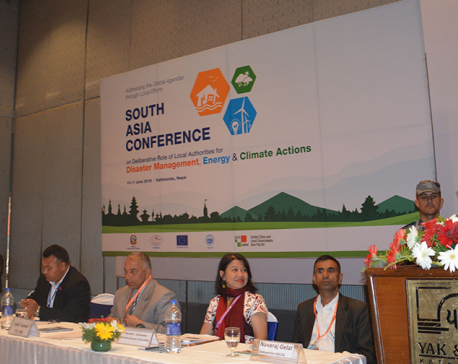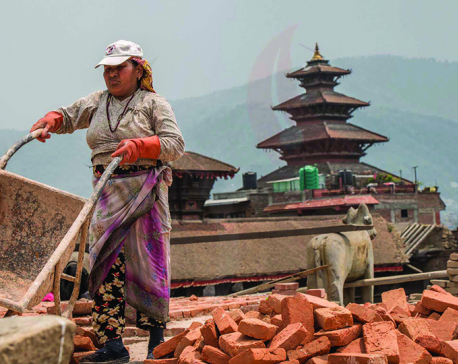
OR

More from Author
Local governments should take initiative for implementing building codes and by-laws. They should also monitor compliance of those laws
Nepal observes fourth anniversary of devastating earthquake of 2015 today. Four years back, 7.8 magnitude earthquake and its aftershocks claimed lives of around 9000 people and injured more than 22000. It affected lives of more than eight million people and hundreds of thousands of Nepalis were made homeless. People were killed as a result of poor infrastructure that collapsed during the earthquake. It was the worst natural disaster to strike Nepal since Nepal–Bihar earthquake of 1934. A number of programs are organized in various parts of Nepal to pay homage to the victims. But this alone does not make any sense, nor make the country safe from future earthquakes.
Building codes are minimum building performance standards that are designed to reduce deaths, injuries and property damage caused by earthquake. Homes that are built using updated building codes are less vulnerable to earthquakes and it makes property damage less likely and less intense. Building code is important tool for earthquake risk mitigation. However, good building codes have little value if they are not well-enforced.
Costs of weak infrastructure
The death toll from 2015 Chile’s 8.8 magnitude earthquake looks like a fraction of 9,000 people who were killed in Nepal six months before Chile earthquake. Why did fewer die in Chile’s earthquake than in Nepal’s? Simple answer is weak infrastructures. In comparison, Chile earthquake, which was stronger than Nepal’s, did not cause human casualties mainly because of strict enforcement of updated building codes.
Statistical analysis shows Chile experiences earthquake of magnitude eight or higher every 15-20 years. However, the damages caused by great earthquake in Chile have been limited in recent years. The real cause is implementation of competent and updated building codes which properly reflect the severity of risk. Chilean official explained to this author when he was in Chile to study earthquake resilience how rigorously enforced building codes limited the death toll. Chile is one example. There are many other best examples where people endure big earthquakes without any losses.
Trained engineers know what stops buildings from collapsing. Unfortunately we are not willing to learn from others. Even during Gorkha earthquake, well-designed buildings withstood tremors and did not claim any lives. Indeed, earthquakes do not kill, poor buildings do. Ensuring proper building code understanding and enforcement may contribute to reducing future earthquake losses.
Shortfalls in compliance with building codes have been identified as a serious problem that contributes to high losses in earthquakes. Though Nepal developed building codes 21 years before 2015 earthquake, Nepal is still struggling to implement them. Immediately after the devastation, the government had indicated to take stern measures to stop the non-engineered construction. Government promised that the building codes would be strictly implemented throughout the country. It had temporarily banned construction of houses above two stories. The government, however, has now backtracked from enforcing the strict provisions and building codes are flagrantly violated. People have started to build their homes without following proper building codes and precautions. According to a survey, thousands of houses were rebuilt by owners without government approval and permission.
Violation of codes
The government is putting efforts to build earthquake resistant building only in earthquake affected areas. Thousands of buildings are being constructed without adopting standard building code elsewhere. If there is another disaster of such magnitude, we cannot rule out huge causalities and property loss. Likewise, earthquake of greater magnitude than 2015’s cannot be ruled out either, because according to a research, that jolt may not have released all the cumulative elastic energy that has been developed since the biggest earthquake in the region about a century ago. It means another massive earthquake could hit the region anytime.
Similarly, researches have also shown that huge amount of energy has already accumulated in a region from Pokhara to Far-Western of Nepal which could trigger an earthquake of higher magnitude. Are we prepared to cope with the situation if it happens? Have we taken precautionary measures to lessen the losses in case of such eventuality?
As things stand, except in few municipalities, most residential and public buildings do not comply with building codes. Though most municipalities have a system of granting building permits to collect the revenue, there is no provision to strength the criteria. One study shows about 85 percent of homes in Kathmandu Metropolitan City have not received ‘construction conclusion’ certificate because their homes do not comply with building codes and bylaws. Those which received such certificates are not earthquake resistant. Who is responsible for this poor implementation of building codes?
More than 98 percent of buildings in Nepal are built by owner-builders using the knowledge of local craftsmen. They are not aware of earthquake resistant construction, nor do they have any access to information related to building codes and incorporation of earthquake-resisting features at nominal extra cost. Inadequate technical expertise in local governments, high professional fees, insufficient public dialogue and lack of code awareness, together, have made implementing building codes difficult in Nepal. Inadequate staffing at local enforcement agencies, legal support, leadership and lack of effort in undertaking enforcement functions and political will have hindered the process. Many local governments do not accord high priority on enforcement of building codes. These pose a significant barrier in effective management of earthquake hazards.
Making safe homes
All local governments should introduce and implement stricter measures to force people to build earthquake-resistant houses and penalize those who violate building codes. First, the owners of the illegally built homes should be barred from receiving government services such as electricity and water. Selling of the illegally-built structures should be strictly prohibited.
The government could provide a period of a year to retrofit weak building to comply with building codes or pull down their illegally-built structures. With these efforts, the government can free the cities from illegally built homes. As many people cannot afford modern reinforced concrete building, concerned department or university should conduct a typological study about specific Nepal housing, including earthquake resistant reinforcement solution.
Many traditional buildings in Nepal were built with earthquake-safe technology hundreds years ago, using timber, brick, stone or mud and lime. Those buildings survived many big earthquakes but might collapse in the next earthquake because materials weaken due to age. We should focus on those traditional houses too.
It is essential to have adequate and updated building and planning codes, as well as proper training and certification for professionals such as engineers, architects, and planners to keep buildings standing. Nepali building codes primarily focus on superstructure and underestimate consequences of the geotechnical condition of building site.
Experience from other countries show more effective a community’s leadership, the greater the likelihood of building code implementation. People are more likely to listen to individuals they know and respect. Awareness of building codes and earthquake disaster, incentives to house owner and mason, and supply of skilled mason etc can contribute significantly in implementing the building codes.
Local governments should take initiative for implementing building codes and by laws. They should also monitor compliance of those laws.
Many nations turn big disasters into opportunities to build safer homes. We should learn from 2015 earthquakes. Local government should utilize this opportunity to build earthquake-resistant cities and villages, so that damages in the next earthquake will be minimum and we can stay in our home fearlessly even in earthquake. Disasters keep coming. We must plan and prepare before the next earthquake which can strike any time.
We have building codes but we have not been able to implement them effectively. Earthquake risk mitigation requires implementation of building codes throughout the country in coordination with local government, engineer, contractors, masons, house owners and many others in the chain.
Improving quality of material and workmanship is essential to develop disaster-resilience society. Raising awareness is equally important. Local governments across Nepal, rise to the occasion.
The author is a PhD Scholar at University of Alberta, Canada
You May Like This

Cooperation urged between federal and local govts for durable reconstruction
KATHMANDU, June 12: Experts in the field of post-disaster recovery and reconstruction have prompted the federal and local governments to cooperate... Read More...

Cause of delay
Reconstruction process in Kathmandu Valley has been affected mainly due to urban poverty. Poverty incidence in Kathmandu has risen to... Read More...

Reimagining leadership
Transitional justice process has not come to a meaningful end because conflict victims were not placed at the center ... Read More...




Just In
- Govt receives 1,658 proposals for startup loans; Minimum of 50 points required for eligibility
- Unified Socialist leader Sodari appointed Sudurpaschim CM
- One Nepali dies in UAE flood
- Madhesh Province CM Yadav expands cabinet
- 12-hour OPD service at Damauli Hospital from Thursday
- Lawmaker Dr Sharma provides Rs 2 million to children's hospital
- BFIs' lending to private sector increases by only 4.3 percent to Rs 5.087 trillion in first eight months of current FY
- NEPSE nosedives 19.56 points; daily turnover falls to Rs 2.09 billion















Leave A Comment